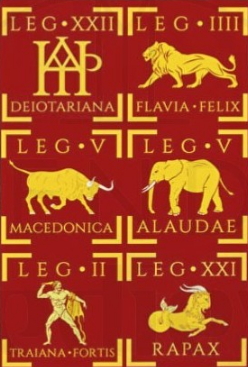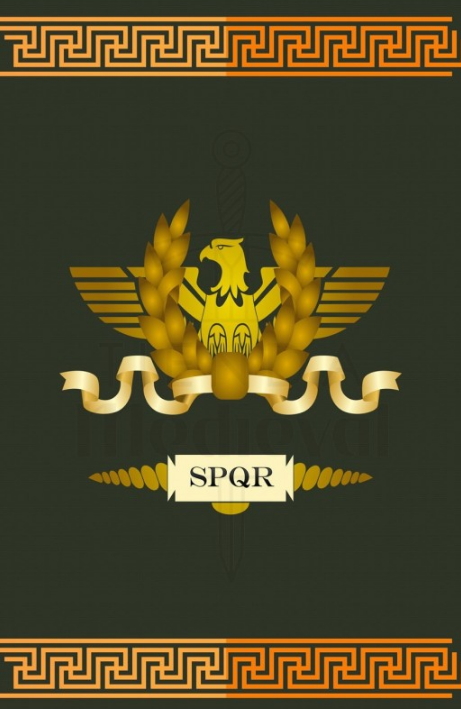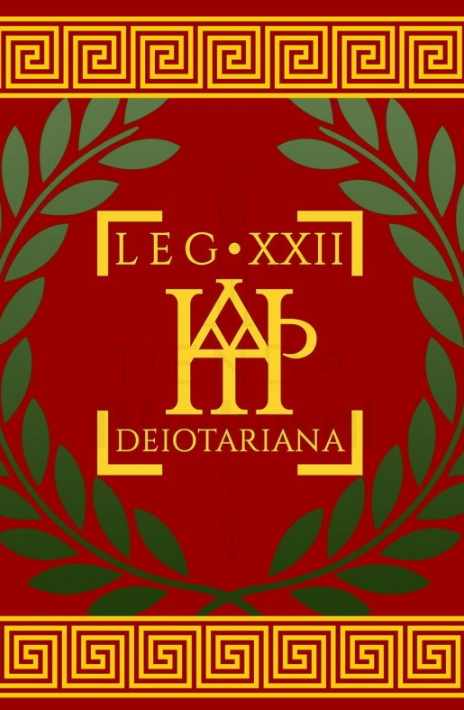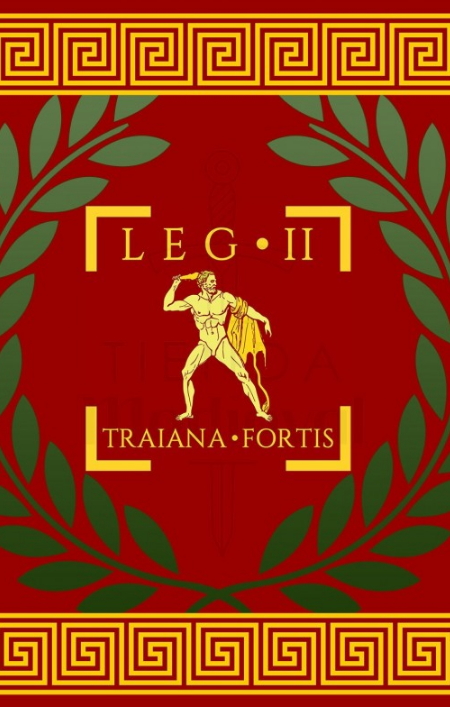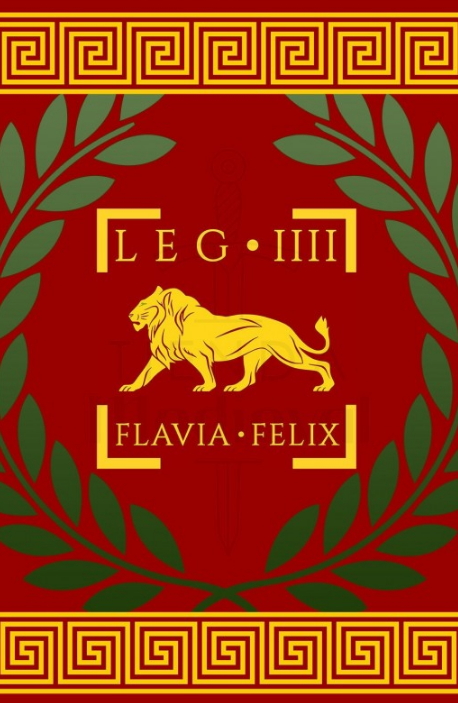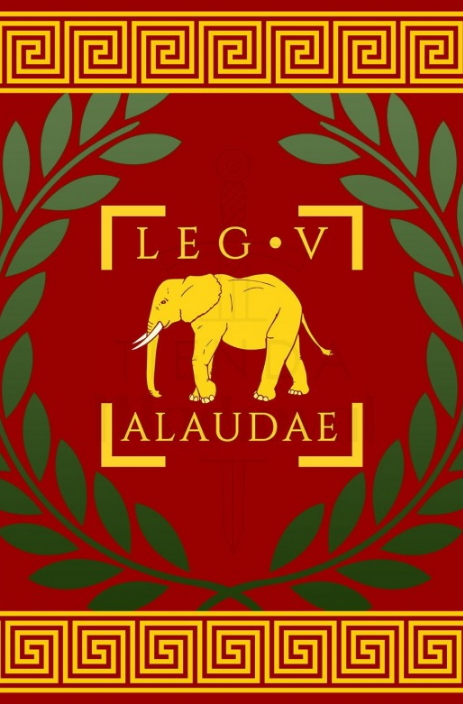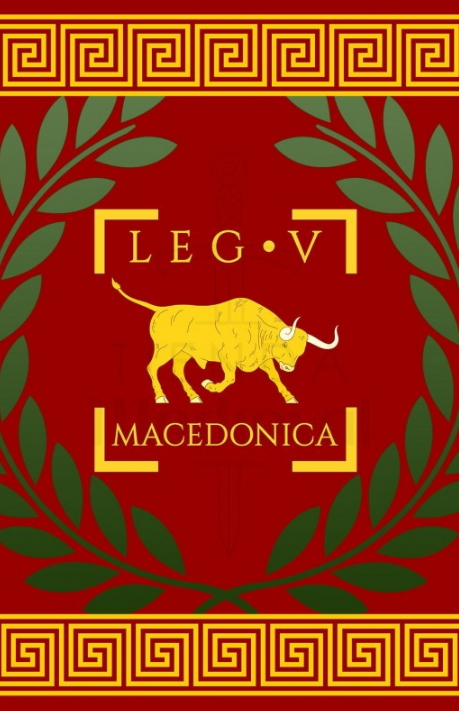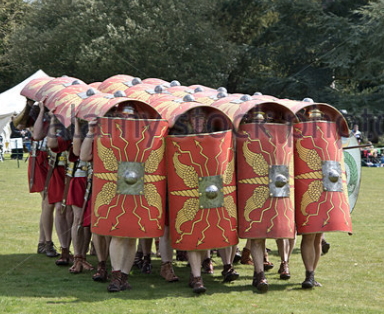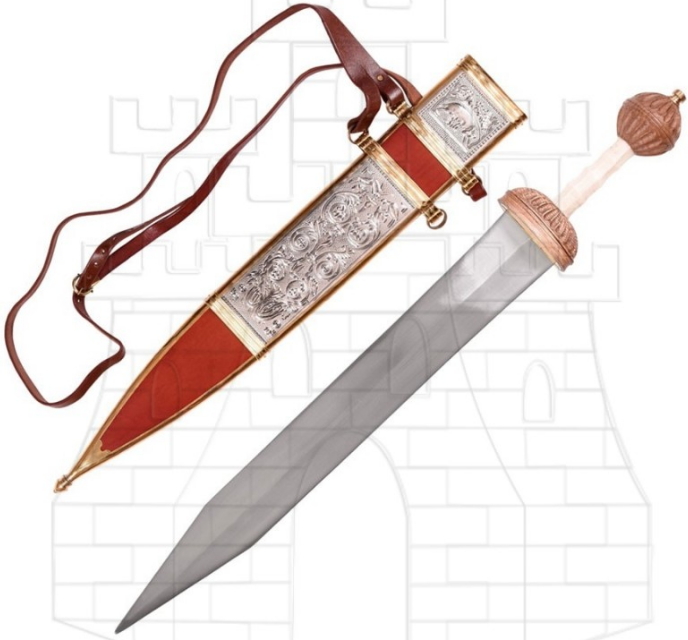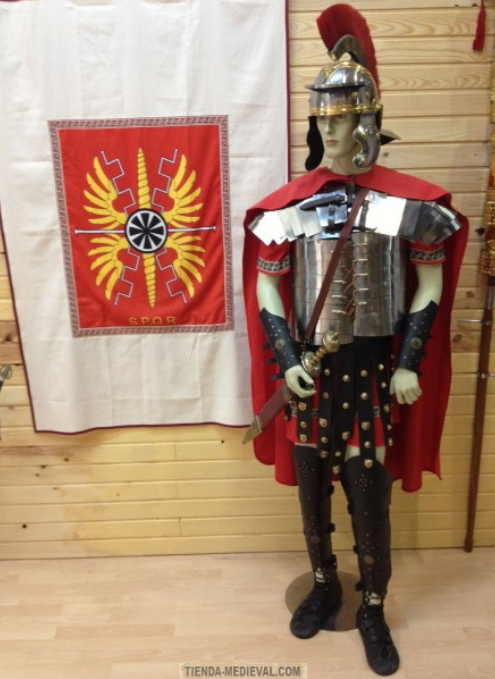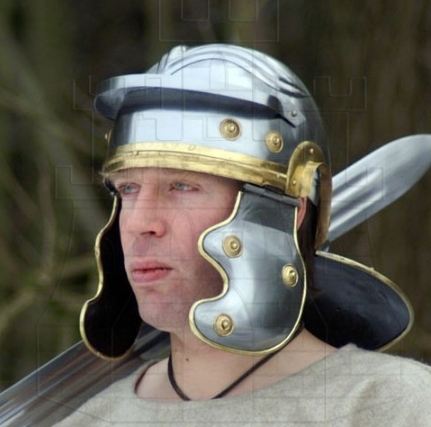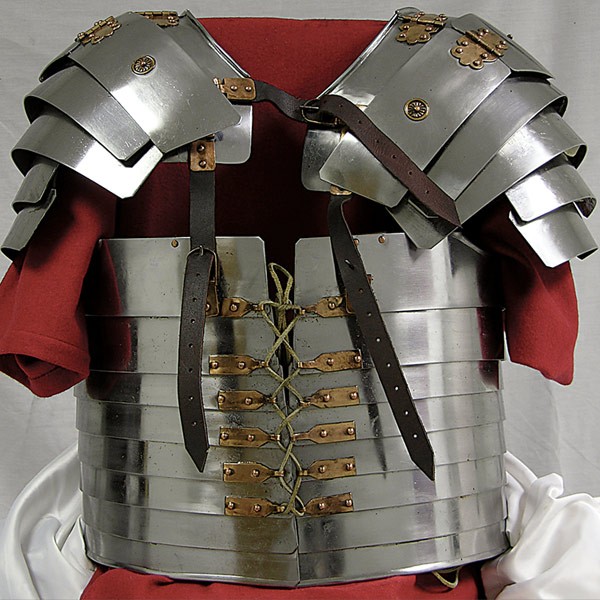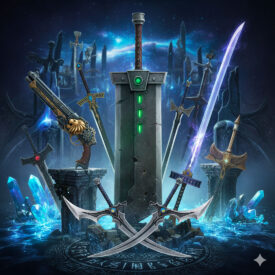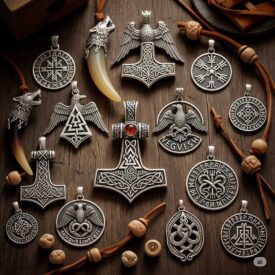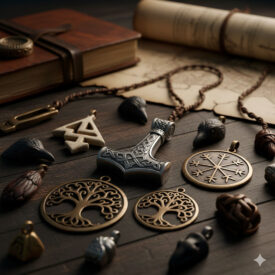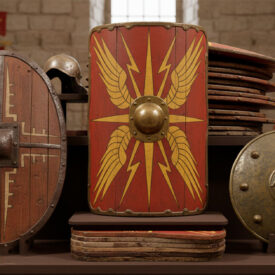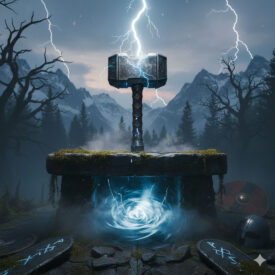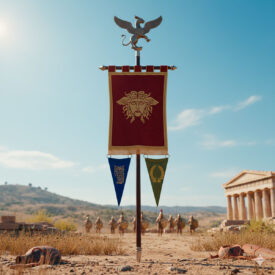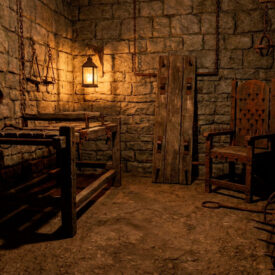The Roman military standards, known as signa militaria, were much more than simple flags. They represented the heart and soul of the legions, serving as indispensable tactical instruments on the battlefield and powerful symbols of identity, honor, and divine connection for the soldiers. Exploring these emblems is like opening a window into the mental universe of the Roman soldier and the society to which he belonged.
Join us on this journey through the main types of standards, their profound meaning, and the crucial role they played in the most formidable army of Antiquity.
Beyond Mere Decoration: The Essential Role of Standards
From their most primitive origins, standards not only united the troops but were objects of worship and veneration. They were considered sacred and inviolable, to the point that seeking refuge beside them could save a life in the midst of a mutiny. Their sacrosanct quality was fundamental, with religious rituals aiming to magically reinforce the power of the unit. They were a physical manifestation of public power and the authority of rulers, linked to ideology, religion, and even the philosophy of the time.
But they were not only symbolic. The standards had a primary tactical function, especially for maintaining formation and cohesion of units in combat. They were essential visual tools for transmitting orders, as the movement of the standard indicated to the troop when to advance, stop, or change position.
The Main Roman Standards: A Symbol for Every Purpose
The Roman army used a variety of standards, each with its own morphology, function, and symbolism:
1. The Aquila: The Soul of the Legion
The Aquila, or eagle, was the most important and prestigious standard of the entire Roman army. It was a free-standing eagle, that is, only the figure of the eagle atop a pedestal and staff, sometimes with minor decorations like a lightning bolt or a laurel wreath. This standard was unique to each legion, and its loss was considered one of the greatest possible disgraces.
- Symbolism: The eagle represented Jupiter’s blessing upon the troop, the numen or divine power of the legion, and was a sign of victory and good omen. It is believed that its adoption as the main standard with Marius’ professionalization of the army (c. 104 BC) sought to foster the unit’s internal cohesion and esprit de corps, gathering all the soldiers under a single emblem. Some historical examples show that it could have a collar with a small bell, possibly as a magical protective element; its metallic sound protected the standard and the unit.
- Indirect Tactical Function: Although primarily symbolic, the Aquila had an indirect tactical value. It accompanied the primus pilus, the commander of the first cohort, serving as a point of reference for his position and a psychological spur for combat. Its movement in battle could inspire the troops to redouble their efforts and avoid its capture at all costs.
- Evolution: Present since at least the 1st century BC with indications of a previous existence, the eagle dominated Roman military emblematics until the mid-3rd century AD, and though it declined, its use persisted until the end of the 4th century AD and even into the Byzantine period. Initially, most eagles had spread wings, but from the 2nd century AD, the model with folded wings became predominant.
2. The Imago: The Emperor’s Face
The Imago was a relief portrait of the emperor or a member of the imperial family, generally small and shaped like a disk (imagines clipeatae). Although its introduction is attributed to Augustus, the oldest visual evidence dates back to the second half of the 1st century BC.
- Symbolism and Function: The Imago served a highly symbolic and propagandistic role, representing imperial authority and the cult of the emperor. It was believed to carry the sovereign’s divine power (numen augusti) onto the battlefield, serving as a powerful magical tool to ensure victory. It was crucial in the unit’s religious-social rituals and in the sacramentum (the soldiers’ oath of allegiance to the emperor).
- Location: The imagines were mainly found in the legion’s first cohort, alongside the aquila. There were two types: the free-standing imago (type I), which was just the portrait, and the signum with imago (type II), which inserted the image into a normal tactical standard. Praetorian units often used signa with imagines.
- Decline: The imago began to disappear with the Christianization of the Empire, as its connection to pagan imperial worship made it incompatible with the new faith.
3. The Draco: Ferocity in Motion
The Draco was a distinctive standard with a metallic dragon or serpent head and a long windsock made of fabric that flapped in the air. Its origin was foreign, probably Sarmatian or Persian, and it was adopted in the Roman army at the end of the 1st or beginning of the 2nd century AD, initially for the cavalry.
- Morphology and Material: The Draco evolved from a wolf/dog-like shape (Type A) to a serpent/fish-like one (Type B), more in line with the Roman conception of the dragon as a monstrous snake. They were made of silk, an expensive material that made the windsock light and allowed the dragon to “hiss” as it moved, which created a psychological effect on the enemy.
- Symbolism: The dragon represented ferocity, animality, hostility, and destruction. It complemented the eagle: while the eagle symbolized the legitimate and celestial power of the army, the draco embodied physical power, wild strength, and terror. Together, they projected a coherent symbolic message of Roman military power.
- Rise: The Draco was immensely successful, and its popularity grew exponentially from the Antonine era, being adopted by the infantry by the mid-3rd century AD. Eventually, in the 4th century AD, it replaced the signum entirely as the main standard of the cohort.
4. The Vexillum: The Versatile Flag
The Vexillum was a standard made of a pole with a horizontal crossbar from which hung a square or rectangular cloth. Its etymology likely comes from velum (cloak, cloth), suggesting a “little fabric.”
- Tactical and Identification Function: Unlike the aquila or the imago, the vexillum was fundamentally tactical and for identification. It was used to signal the presence of a military commander or the emperor, to identify military units (often with inscriptions on the cloth), or for temporary detachments (vexillationes).
- Evolution and Types: There were simple vexilla, epigraphic (with names of generals or units), and illuminated (with figures or symbols). From the time of Constantine I, Christian variants appeared, such as the labarum (with the Chi-Rho, a monogram of Christ) and the vexillum with the cross. Vexilla with “brackets” or corners at the edges of the fabric were also recorded, believed to have had magical-protective value, defining a sacred space.
- Material and Color: Initially made of wool, later of linen, especially in the Eastern Empire. It is known that vexilla used for military mobilization were red in color.
5. The Signum: The Composite Standard
The term Signum had a dual meaning: it could refer to any type of standard in a generic sense, or, more specifically, to a composite standard. The latter was formed by two or more elements on the staff, excluding the aquila, vexillum, draco, and the imago when they were free-standing.
- Common Elements: Signa were often topped with a spearhead (moharra) or an open hand (manus). Other decorative elements included phalerae (metal disks, often with a central umbo, believed to have been collective military decorations), crowns (vegetal or civic, also as decorations), tassels (often with a protective or ornamental meaning), crescents (an astral and prophylactic symbol), globes or ovals, and zoomorphic shapes or divinities.
- Function: The main function of the signum was tactical, serving as the standard of minor military units (maniple, century, or cohort) to maintain order and cohesion within the company and to transmit visual orders. It also had a moral function, acting as an ideological glue and an internal cohesion tool.
The Military Organization and Life of the Legionary
The Roman legion was the basic infantry military unit of ancient Rome. It consisted of a body of heavy infantry of about 4,200 men, later reaching between 5,200 and 6,000 infantry soldiers and 300 cavalrymen. Legions were assigned a name and a number. Usually, there were 28 legions with their auxiliaries. The legions were commanded by a legate or legatus.
Around thirty years old, the legate was usually a senator for three years. The immediate subordinates of the legate were six elected military tribunes: five regular officers and the sixth, a nobleman representing the Senate. There was a group of officers providing medical services, engineers, chroniclers, and the praefecti castrorum (prefect or camp commander), who had served as primus pilus, or first centurion—a highly respected figure. Below the primus pilus were the centurions, who had an optio as a subordinate. Below were the mass of legionaries, among other specialists such as priests and musicians.
By the mid-Republic, the legions comprised the following units:
- Cavalry or equites: This was the most prestigious unit, where young, healthy Romans began to distinguish themselves before embarking on political careers. The necessary equipment was paid for by each cavalryman and consisted of a horse, round shield, helmet, body armor, sword, and one or more javelins. The legion’s cavalry was outnumbered. In a total of about 3,000 men, there were only about 300 cavalrymen, divided into 10 units of 30 men. Each unit was led by a decurion. To this heavy cavalry was added a light cavalry, recruiting poorer citizens and young men in good health, but not old enough to join the hastati or the equites.
- Light infantry or velites: They were basically javelin throwers and skirmishers in general and did not have a precise formal organization or a function on the battlefield. They were used as needed and came from the lower economic strata of society.
- Heavy infantry: This was the legion’s main unit. It was made up of citizen legionaries who could afford the equipment: a bronze helmet, shield, armor, and short spear (pilum). The preferred weapon was the gladius, a type of short sword.
The heavy infantry was subdivided according to the experience of the legionaries into three separate lines:
- The hastati: were the youngest and formed the front line. They were armed with two pila of different weights, so that one had longer range and the other could pierce shields. In close combat, they used swords. For armor, it was common to use bronze plates held with leather straps, covering the heart and part of the chest. They also used bronze helmets and the scutum.
- The principes: these were men around 30 years old, composed the second line of the legion, and were armed like the first, but instead of a chest plate could afford a chain mail cuirass.
- The triarii: were veteran soldiers and formed the rear line, joining the fight only in extreme situations. Unlike the principes, instead of the pila they wielded a long spear, forming a solid phalanx bristling with spear tips that held back the enemy.
Legion Structure and Battle Tactics
Each of these lines was subdivided into maniples, the smallest subunit of the army, composed of two centuries commanded by the senior centurion. The century as a combat unit was made up of 80 men. Its name comes from being the unit that follows the centurion. It is often wrongly thought that they had 100 men because “century” is associated with one hundred. Each century had its own standard and was composed of ten units called contubernia. In a contubernium, there were eight soldiers sharing a four-person tent (the other four would always be on guard), a millstone, a mule, and a kettle (depending on the journey’s length).
In battle, maniples were commonly organized in a square formation called quincux. The maniples of principes filled the gaps left by the hastati, their own gaps in turn filled by the triarii. When a legion was deployed in combat, each century would normally form a square of 10 men across and 8 deep. Thus, one century would stand behind another, forming a maniple that made a square of 10 men across and 16 deep.
In the cohorts, the three maniples would form together in a line, but leaving enough distance between them so that the second century of each maniple could occupy the space between the centuries in front. This formation, arranged with three centuries across and two deep, would occupy a space on the battlefield of about 75 meters across, but with a 15-meter gap on the left flank, so that the second line century at the left could move into this space.
The cohorts were generally arranged in three lines called acies, or at least for Caesar, the “triplex acies” formation is the usual one. If there were fewer troops, they could also form a acies duplex, meant to maintain the same battle line against a numerically superior foe, thus avoiding being outflanked and, once surrounded, defeated. As a legion was made up of ten cohorts, the triplex acies formation forced one line to have one more cohort than the other two. It was common to have cohorts from different legions deployed together on the battlefield, but always with the cohorts of the same legion as near each other as possible.
All the Legion Standards at Your Disposal
We have an extensive and carefully curated collection of Roman legion standards, recreated with great historical fidelity. If, while browsing our catalog, you notice the absence of a particular standard, don’t worry. We specialize in the design and manufacture of custom pieces, so we can create it specifically for you. Once finished, we’ll not only make it available for you, but we’ll also add it to our permanent collection so other enthusiasts can enjoy it too.
The Standard Bearer: A Role of Honor and Responsibility
The soldiers responsible for carrying the standards were figures of great prestige and responsibility in the army.
- Hierarchy: The Aquilifer (bearer of the Aquila) was at the top of the hierarchy among standard bearers, a very coveted and well-paid rank. They were followed by the Imaginiferi (Imago), Draconarii (Draco), and Signiferi (Signum). The Vexillarii (Vexillum) often held a lower rank, but their role was equally crucial in transmitting orders.
- Tasks: In addition to their duties in battle, standard bearers had important administrative responsibilities, such as keeping the unit’s accounts and safeguarding soldiers’ money deposits. This is why they had to be educated, reliable, and able to read and write. They were often depicted with wax tablets for writing, symbolizing their administrative function.
- Attire: Standard bearers were recognizable by the animal-skin hat (such as bear, wolf, or lion) they wore over their helmets, a tradition that, according to sources, was meant to instill fear or awe in the enemy. They also often carried small round shields (parma).
Legionary Requirements and Training
Those wishing to become legionaries had to present themselves at recruitment offices established throughout the Roman-controlled territory; there was usually one in each major urban center. Upon arrival, they had to be prepared to meet a series of requirements to guarantee acceptance into the training phase. The essential requirements were:
- Have an average body build, slender but in good nutritional condition.
- Have no vision or hearing problems.
- Be able to read and write in Latin.
Once accepted, they had to swear an oath of obedience to their superiors, as well as promise never to desert. Once this was done, they were assigned to a detachment and sent off to begin the training stage.
Training served two purposes: strengthen the body and teach individual combat techniques and formations. Marches were very important due to their tactical significance, since the faster they marched, the sooner they entered combat. Marches were carried out regularly regardless of the weather. All soldiers carried equipment weighing about 25 kg and marched 30 km in five hours. Legionaries also learned to build camps to sleep in after their marches.
Another part of the training, without a doubt, was learning formations, as these were what differentiated a Roman legion from a group of barbarians. Legionaries knew how to execute line relays, tortoise or testudo formations, and all kinds of deployments. Legionaries practiced with heavier, weighted dummy weapons, so that standard weapons would feel lighter. Legionaries were taught to blindly obey orders, and those who disobeyed were harshly punished by lynching, stoning, or decimatios, carried out by their own companions.
A Reflection of Rome
The evolution of Roman standards is a fascinating reflection of ideological and political changes in society and the army. From humble bundles of straw to elaborate dragons and imperial effigies, every standard told a story of power, faith, and cohesion, making them not just military tools but authentic protagonists in the destiny of Rome. Studying them enables us to understand the complex symbiosis between the practical and the sacred that characterized this age-old civilization.
Explore Rome’s History with a Unique Piece
For those passionate about Roman history and its fascinating standards, or for anyone seeking a decorative piece that evokes the power and glory of the Empire, in our shop you’ll find a selection of products inspired by this era. Immerse yourself in the world of the Roman legions and relive the grandeur of Antiquity with a quality replica that pays homage to these symbols of power and honor.


